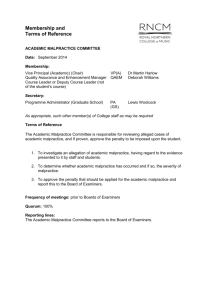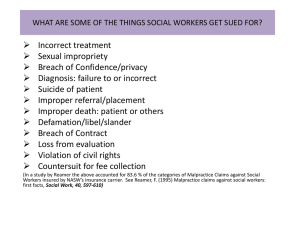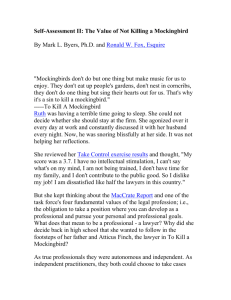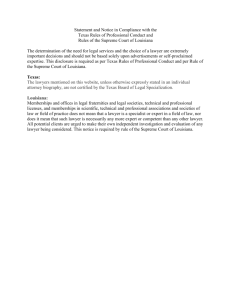A Guide To Purchasing Lawyer`s Professional
advertisement
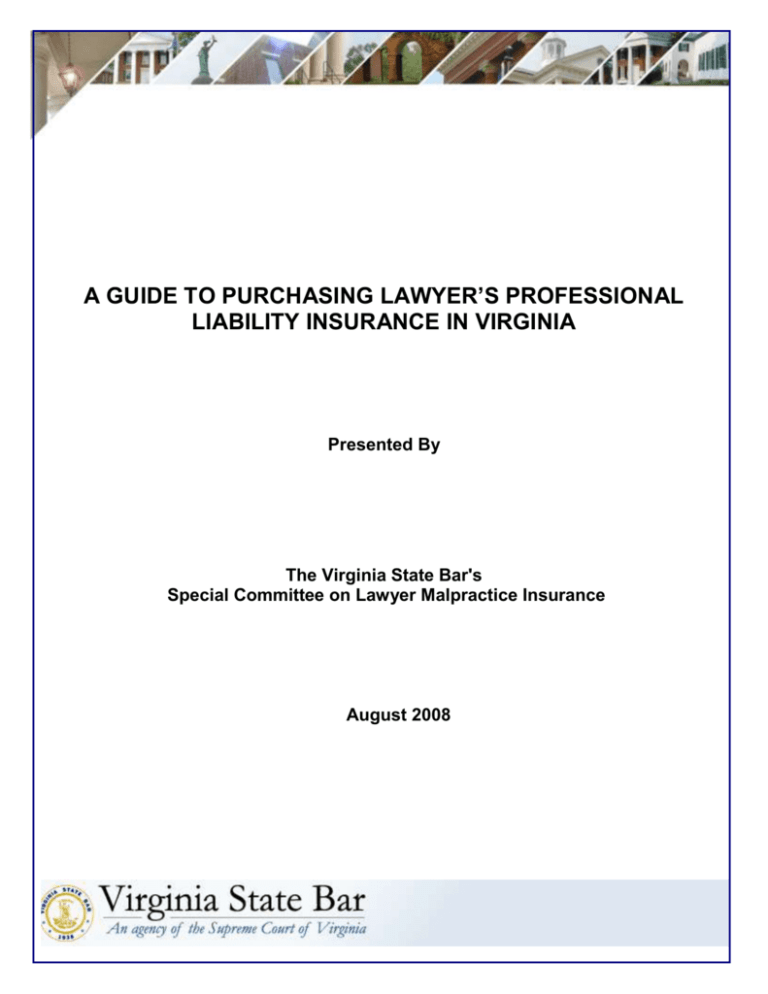
A GUIDE TO PURCHASING LAWYER’S PROFESSIONAL LIABILITY INSURANCE IN VIRGINIA Presented By The Virginia State Bar's Special Committee on Lawyer Malpractice Insurance August 2008 102131.1 The Need For Professional Liability Insurance Malpractice insurance is essential to: Reduce the chance that a claim will result in a severe financial hardship; Provide the insured lawyer with objective advice when faced with a malpractice claim; Assure a prompt and reasonable settlement or dismissal of a claim; Provide access to valuable risk management resources; Save time and reduce the frustration of dealing with spurious claims; Provide protection for a lawyer’s reputation; and Ultimately, protect the client’s interests in the face of a credible claim. Although the debate over mandatory insurance continues, as of today lawyers in Virginia are not required to maintain malpractice coverage. However, many of the Commonwealth's citizens assume to their detriment that they will have access to compensation in the event their lawyer commits an error. To our credit as a profession, most Virginia lawyers in private practice recognize malpractice litigation as an ever present risk for today's professional and protect themselves, as well as their clients, accordingly. To help our members meet that threat head on, the Virginia State Bar supports the work of this committee and works closely with the Lawyers Liability Protection Society ("ALPS"). ALPS is the endorsed malpractice carrier of the Virginia State Bar (“VSB”) and it provided this committee with concrete data to help understand the risks and the solutions available in today’s market place. For example, more than 4% of lawyers insured by ALPS submitted potential malpractice claims in 2007. ALPS’s clients represent a cross-section of the lawyers in Virginia, so we can conclude that, on average, a firm of 20 lawyers will likely have a malpractice claim every year of its existence. In spite of this substantial and growing risk of claims, the VSB's records indicate that as of 2007 approximately 2,000 of its members who represent clients drawn from the general public (almost 12%) are practicing without any malpractice coverage. We respectfully submit that this lack of preventative action is ill advised. The Special Committee on Lawyer Malpractice Insurance has created this guide as a resource to assist lawyers in making informed decisions when purchasing professional liability coverage. The Parties The insured is you, the lawyer or law firm purchasing legal malpractice coverage. The named insured is also sometimes referred to as “the policy holder”. The Policy Pointer: Coverage is generally only valid for work done on behalf of the “named insured.” If you do or did work on behalf of insurance company or "carrier" is other firms or outside agencies, it is likely that this work will not be the primary company that provides covered under your standard policy. Be sure to disclose any prior the policy form, terms, conditions, outside work to your insurance provider and discuss what coverage and limits. The carrier handles your options are available to you. claim in conjunction with the local 102131.1 defense lawyer assigned to your claim. It is the source of your insurance product and provides coverage for claims against you. In some cases the carrier will be a direct writer and in other instances the carrier will be represented by a broker. A direct writer markets and sells its products through employees of the carrier or agents who have substantial expertise in the specific company’s policy. A broker works as an intermediary between multiple carriers and the lawyer requesting insurance. Both direct writer agents and intermediary brokers will assist you in obtaining the proper coverage, answer questions about coverage and detail the limits of liability that fit your practice profile. They will also discuss current claim trends and assist with legal malpractice prevention programs. You should work with direct writer agents or brokers with specific expertise in lawyers’ professional liability insurance within the Virginia market. The Paperwork There are four basic documents you need to know about: the Application, the Declarations Page, the Certificate of Insurance, and the Policy. In the Application, you provide Policy Pointer: Some companies use the term “Maturing Lawyer” to the carrier with information refer to lawyers whose loss inclusion date is relatively recent. As an regarding yourself, your firm and lawyer builds up a longer client history, the window of exposure opens your practice. The carrier then wider, and consequently the premium for that individual lawyer will takes that information and increase. Because of this rating procedure you should be aware that determines what type of risk you premiums in the first year of the policy tend to be lower but increase present, in what is called the steadily for the length of the ‘maturing period’. underwriting process. The most important factors in the underwriting and premium setting process are: claims history, firm size, jurisdiction, loss inclusion date and areas of practice. To obtain an accurate quote, it is essential that you report this information fully. For most purchasers, completing the application is the most difficult and time consuming part of the insurance process. Some carriers provide forms that can be completed digitally or as online applications that Application Pointer: When filling out the you can complete at your convenience. If you are Application, never withhold specifically evaluating whether it is worth your time to complete a requested information, however damaging it may appear to be. Dishonesty at the new application, you can sometimes use one application stage can result in the carrier application for several carriers to get an idea of what voiding the policy, leaving you without the pricing is like. A few companies even have shortcoverage for a claim. form indication sheets that you can complete in just a few minutes to get a non-binding estimate. The Declarations Page, as its name suggests, is generally a one page document that the carrier will provide outlining the terms of your coverage including: the named insured, the policy's period, the limits of liability on a per claim and aggregate basis, and your deductible. Some policies list the prior acts (retroactive) date on the Declarations Page and others identify this date in an endorsement. This short summary details all the most important features of your policy in an easily understandable format, and is generally sufficient proof of insurance if requested by one of the groups or individuals for whom you provide legal services. The Certificate of Insurance is a similar form, which also serves as proof of insurance, but in circumstances where a more recent document is required. If you are working, for example, with a Real Estate Title company, they will often require proof of insurance as of the date of closing. In this 102131.1 case, the Certificate of Insurance is the best document available because it is generated not at the date of policy issuance, but as of the date requested, which assures that there has not been a lapse in coverage. Also, unlike the Declarations Page, which is provided directly to the named insured, the Certificate of Insurance is sent from the insurance company to the agency requesting the proof of insurance, adding an additional layer of security. Most companies require that the Certificate be requested in writing, but some companies will accept a verbal request or have developed an automated online process for generating Certificates to help streamline the process for lawyers who need faster service. The Policy is the contract which governs the relationship between the company and the insured. The standard parts of the policy are: the Definitions, Coverage Agreement, Exclusions, Defense & Settlement Provisions, Limits of Liability, Conditions and Endorsements. Definitions usually identify for whom coverage is provided. Examples of terms commonly used in the policy include: Named Insured; Predecessor Firms; Former Policy Pointer: Be cautious when reviewing the definitions. For example most, but not all, policies provide coverage for work done on lawyers, partners & behalf of the firm by former lawyers. This is important to determine shareholders; Future lawyers, whether and under what circumstances departing lawyers will need to partners & shareholders; purchase extended reporting endorsements to protect them from claims Former, current, or future nonarising as a result of prior acts. lawyer employees; and Lawyers serving in an "Of Counsel" capacity. The Coverage Agreement identifies the services, activities or actions that may be covered. It is well to keep in mind that malpractice policies are generally "claims made" coverage rather than "occurrence" coverage. Auto and property insurance, for example, are occurrence types of coverage. With an "occurrence" based policy, even though the policy may have expired, provided the policy was in force at the time that the loss occurred, a claim can still be made against it. Where a policy is written on a "claims-made" basis, meaning that the policy in effect at the time a claim is made against you will pay for losses, regardless of when the error occurred. This is true so long as the policy does not have a constraint placed upon the retroactive date due to occurrences such as gaps in coverage. In general, legal malpractice policies may cover the following activities: • Services as an lawyer; • Services as a mediator or arbitrator; • Services as a title agent; • Services as a trustee or executor; • Services as a notary public. The Exclusions identify what activities are not covered by a policy. If and when you file a claim with the carrier, it will make a determination whether the claim is covered or excluded. Often times, it utilizes outside coverage counsel to make this determination. If the carrier concludes that coverage for the claim is excluded under the policy, then it will issue a detailed, written notice to you setting forth the basis of its denial. Many times, a malpractice plaintiff will plead several causes of action in the alternative. For example, a legal malpractice claim may be expressed in Virginia as Policy Pointer: When choosing malpractice either a negligence or breach of contract claim. Plaintiffs insurance, it is well to speak with other routinely plead both of these claims in their complaints, lawyers about their experiences with their and in so doing, include claims of fraud or other intentional current and prior malpractice carriers. torts, which are not covered under a standard malpractice policy. When faced with a lawsuit containing covered and 102131.1 uncovered claims, the carrier will issue what is known as a "reservation of rights" letter identifying the claims for which it will not provide indemnity coverage in the face of an adverse judgment. Because a carrier's duty to defend is broader than its duty to indemnify, many times a carrier will continue to pay the costs of defense, even for the uncovered claims. Examples of excluded activities can include: Dishonest acts; Fraudulent acts (Actual Fraud); Criminal Acts; Malicious Acts; Worker's Compensation Claims; Bodily Injury or Property Damage; Punitive Damages; Sexual Harassment; Discrimination; Activities on Behalf of Family Members; Disciplinary Proceedings; and An lawyer's actions or omissions while serving as an officer, director, etc., of a business not owned or controlled by the firm (including an lawyer's service in a local or specialty bar association). Some carriers will provide limited coverage for certain types of claims through the use of special policy or endorsement even if the carrier would normally be excluded. For example, lawyers who regularly provide services on behalf of not-for-profit agencies on whose board they serve can request that coverage be added to the policy for that work, so long as it is requested as part of the application process and approved by the underwriter. Also, you should be aware that there can be protection under the "innocent actor/party" provision in most policies for partners who did not participate in the intentional, dishonest, criminal, fraudulent or malicious acts of the co-defendants to a claim. Defense & Settlement Provisions include items such as choice of defense counsel and consent to settle provisions. Under most policies, the carrier has a list or panel of approved defense counsel it uses for each jurisdiction. When an insured submits a claim, the carrier will then assign one of its approved counsel to represent the insured. Some carriers have a standard policy provision which allows the insured to participate in the selection process rather than forcing policy holders to rely solely upon the carrier's decision. Likewise, most policies require an insured's consent prior to a settlement. This issue can be quite important for the lawyer who believes that he or she did not breach the standard of care. Nevertheless, most policies also have a "hammer clause." If the carrier makes a determination that a settlement is appropriate and you still withhold consent, the hammer clause allows the insurer to protect itself by limiting its liability to the amount of the proposed settlement, leaving you on the hook for any judgment above and beyond that settlement proposal. The Limits of Liability are perhaps the most important part of any malpractice policy. In this section, a policy will identify the per claim and aggregate limits of liability, defense cost allocation, and the deductible. A policy's limit is usually expressed in a per claim/annual aggregate manner. For example, given the current claims experience most companies are seeing, the minimum recommended coverage for a solo private practitioner is $250,000 per claim and $500,000 aggregate or “$250,000/$500,000.” This means a lawyer has $250,000 in indemnity coverage for each claim filed for that policy period and up to a total of $500,000 per policy period for all tendered claims. In determining the proper policy limit, a lawyer should consider the nature and extent of his or her practice. Obviously firms with more lawyers should generally carry higher limits, as should firms who handle cases of larger than average monetary worth at stake. 102131.1 Policy Pointer: To account for differences between “inside the limits” and “outside the limits” policies, you can subtract the anticipated defense costs from the per claim policy limit. You must be cautious when estimating your defense costs, because complex litigation can be very expensive. By way of example, let us assume the average cost for defending substantiated claim in the State of Virginia is $40,000. A $250,000 per claim policy limit with defense costs inside the limits becomes the rough equivalent of a $210,000 per claim policy limit. However, when it comes to Defense Costs, some policies can be misleading. Most malpractice policies provide that defense costs are "inside the limits of liability." A policy that has defense costs inside the limits of liability is "self-liquidating" or "cannibalizing" in nature. This means that each dollar expended in defending the lawsuit, i.e., lawyer's fees and expenses, is deducted from the policy's limit thus decreasing the amount available to pay the plaintiff in settlement or judgment. Some policies also have a "claims allowance expense." A policy with this type of clause provides that the insurance carrier will pay a certain amount of money towards defense costs before the policy's limits begin to self liquidate. After that figure is expended, the remaining defense costs are deducted from that policy's limits. Obviously, a policy with these types of provisions can drastically reduce the indemnity coverage you thought you were purchasing. As such, when you are purchasing a policy you should carefully consider whether you want either of these provisos. Another important factor is a policy's Deductible. Most malpractice policies contain deductible clauses. A deductible can be applied on both a per claim and an aggregate basis. There are many different options regarding when and why an insured may have to pay his or her deductible and this issue should be fully discussed with the carrier or broker prior to obtaining a policy. If that deductible is what as known as a "first dollar defense" or a "loss only" deductible then you only pay your deductible if and when a settlement is reached or an adverse judgment is entered. Based upon ALPS’ experience in Virginia, 62% of all claims for which defense costs were incurred resulted in no actual losses. If those lawyers all had first dollar defense, they would not have incurred any out of pocket expenses to resolve what unsubstantiated claims were, by and large,. For obvious reasons, this is an attractive option in many malpractice policies. The Conditions section of a policy may include, but is not limited to, the following: • A requirement that you, the insured, provide timely notice to the carrier of all claims and potential claims; • A subrogation provision in favor of the carrier; and • A requirement that you, the insured, assist and cooperate with the carrier and defense counsel in defending against the claim. Lastly, you should closely review the Endorsements and/or Riders to the policy. Whereas the body of the policy is form in nature and meant to apply to all insureds, the Endorsements tailor a policy on a lawyer-by-lawyer basis. Endorsements can do many things, including, adding or limiting a policy's coverage, and identifying additional insureds. Perhaps the most important endorsement any lawyer will obtain in his or her career is when an existing policy is about to lapse because the firm is dissolving or the lawyer is retiring. At that point, the lawyer should consider obtaining an "Extended Reporting Period Endorsement." This endorsement is often times colloquially, and indeed erroneously, referred to as "tail coverage." It is not, in fact, new or different coverage or a new policy. Rather, the Endorsement simply extends the time under the old, lapsing policy during which the lawyer can submit a covered claim to the insurance carrier for defense and indemnity coverage. Unless the departing lawyer is covered by “former attorney language”, he or she should strongly consider purchasing this additional endorsement, especially since several companies offer free and/or low cost extended reporting if the 102131.1 lawyer becomes disabled, dies, retires, after being insured for a specified number of consecutive years with the same carrier. Conclusion The legal malpractice insurance market is complex and offers many different options for Virginia lawyers. Exercise caution and good judgment when you compare your options to make sure that you and your client are going to be protected if, and when, a claim is presented. The Committee would like to acknowledge and thank ALPS for its assistance in preparing this Guide. 102131.1


